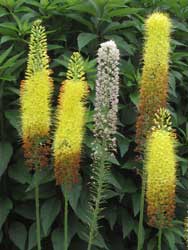Resource Library
Plant of the Week: Lily, Foxtail (Desert Candle)
The University of Arkansas System Division of Agriculture does not promote, support or recommend plants featured in "Plant of the Week." Please consult your local Extension office for plants suitable for your region.
Plant of the Week
Desert Candle
Latin: Eremurus x isabellinus

As fall approaches, it is time to once again get serious about putting together a bulb order for the spring garden. While tulips and daffodils garner most of the space in the catalogs, there are many other interesting species worth checking out. A group that caught my attention recently was the foxtail lilies or desert candles (Eremurus x isabellinus).
Foxtail lilies are tuberous, rooted, herbaceous perennials long classified in the lily family. But in 2009, modern DNA based taxonomists moved it to an overarching family called the Xanthorrhoeaceae and now treat it as a close relative of aloe, bulbine and haworthia and a more distant relative of daylilies. Plants have narrow leaves to half an inch wide and a foot long arising from a crown of slender, tuberous roots that radiate out horizontally like spokes of a wheel. The leaves emerge with the shoot in the spring and die away by early summer.
The flower spike, depending on the species used to create the hybrid, will be from 3 to 5 feet tall with a bottlebrush-type inflorescence that occupies the upper half of the stem. Blooming is usually late spring or early summer. Each stem will be crowded with 500 to 700 half-inch wide, six-tepaled, star-shaped flowers in shades of yellow, white, bronze, orange or pink. The flowers open from the bottom up, with individual stems remaining effective for two weeks or longer. The scape continues to elongate as the pea-sized seed capsules develop.
Eremurus species are beautiful plants from a part of the world that is both difficult to reach and from areas that have had a long history of conflict. Because of these factors and the fact that Central Asia is an enormous tract of ground, the genus is still relatively unknown. Between 40 and 50 species have been described, but only a few have ever been grown in gardens. The genus name was first used in 1810 and translates from Greek as "desert" plus "tail."
The first hybrids were produced in 1902 by Sir Michael Foster (1836 - 1907), a medical doctor who taught physiology at Cambridge in England, using E. olgae x E. stenophyllus. From these first hybrids, clones were selected and propagated vegetatively. In the 1950s, Ruiter Hybrids were developed by a Dutch nurseryman using some of the Foster's original hybrids to create the named clones now offered in bulb catalogs. ‘Cleopatra,' a striking orange, is probably the most common of these.
The desert candles offered in the catalogs are the product of a kind of Darwinian selection process. The hybrid seedlings that survived in Foster's and Ruiter's seed plots were those plants that would tolerate a decidedly non-desert environment. Tulips hail from the same region as desert candles and the same process has occurred in selecting those flowers, but it has been going on for four centuries, not one. In a kind of interesting twist to this approach, Ken Romrell, a cut flower grower in Spring Valley, Idaho, is now offering desert candle hybrids grown in a climate more like the steppes of Central Asia than the cool, dank climate of northern Europe.
Desert candles require full sun locations in rich organic soils that are well drained, especially in the winter. They are hardy from zones 5 through 9. Mixing sand into the planting bed or raising the bed is advisable if poor drainage is suspected. A broad hole with a cone of loose, sandy soil should be placed in the planting hole and then the roots fanned out from the central crown, which should be planted 2 inches deep. When plants have finished flowering, the clump should be allowed to dry out over summer.
Excessive summertime irrigation is sure to cause roots to rot. Desert candles resent being disturbed once established, so plant them where they can be left alone. If division is needed, do so in late summer and replant the division immediately. Plants can be grown from seed, but 4 to 5 years is required to see the first bloom.
By: Gerald Klingaman, retired
Extension Horticulturist - Ornamentals
Extension News - August 20, 2010
The University of Arkansas System Division of Agriculture does not maintain lists of retail outlets where these plants can be purchased. Please check your local nursery or other retail outlets to ask about the availability of these plants for your growing area.